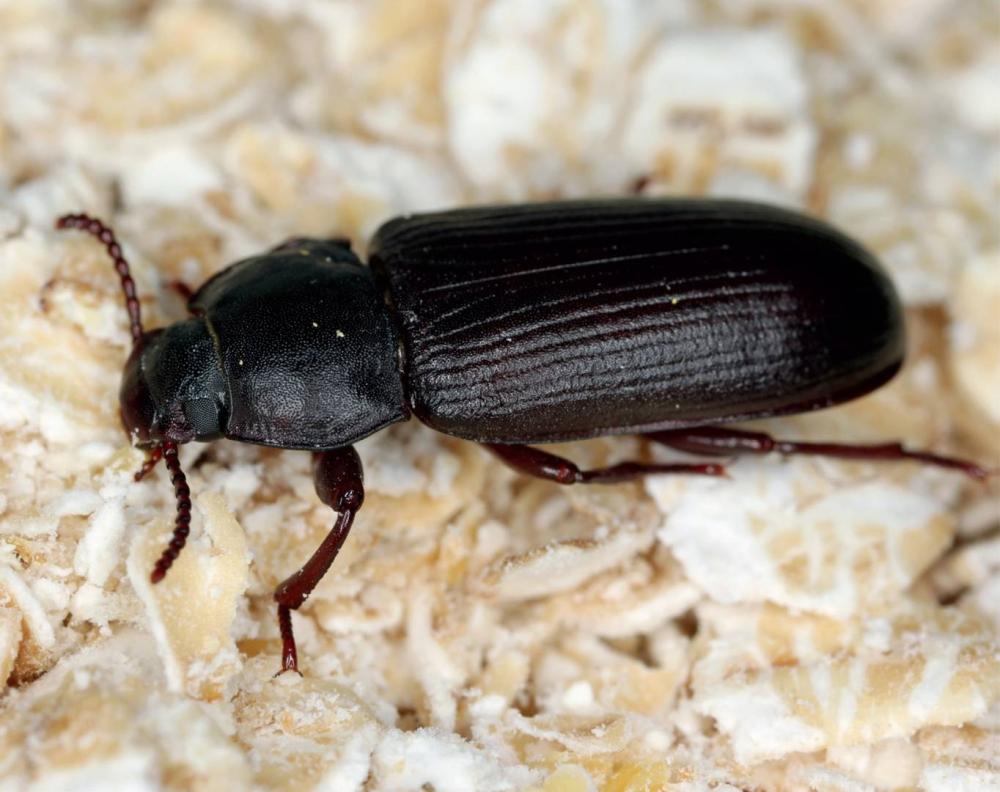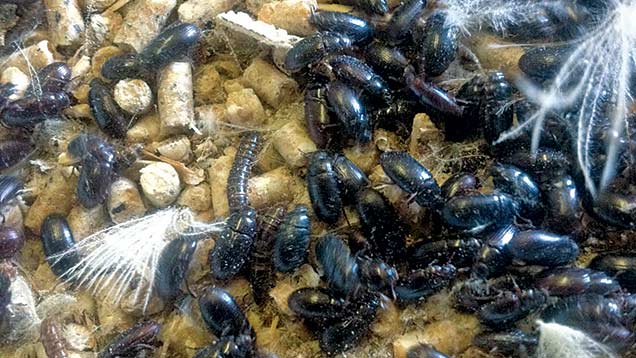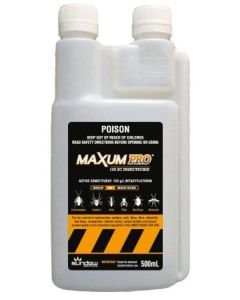Litter Beetle
- Article
- Litter Beetle
Litter Beetle
Scientific Name: Alphitobius diaperinus
How to identify a litter beetle
Adult litter beetles are dark brown and 6-7 mm long, beetle larva are light brown-yellow in colour.

Where are litter beetles commonly found?
Litter beetles are commonly found in poultry houses and runs.
Why are litter beetles considered a pest?
Litter beetle larvae cause damage to poultry house insulation as they chew through the insulation to create harbourage sites within which they pupate. Adult beetles may also lay their eggs within these tunnels. This damage can be intensified by insect-seeking birds which enlarge the beetle-created holes as they dig out the pupating beetle. Both adult beetles and larvae can harbor various poultry pathogens, including bacteria like Salmonella and Escherichia coli, as well as viruses including the causative agents of both Newcastle and Marek’s disease. Beetles are also intermediate hosts for the chicken tapeworm (Choanotaenia infundibulum) which can parasitize birds that feed on these beetles. Beetles can be nuisance pests at neighbouring properties, especially when a large quantity of beetle-infested litter is removed from a poultry house and piled to dry. As the litter dries, adult beetles removed with the litter will disperse by flight throughout the surrounding environment.

What is the biology and lifecycle of a litter beetle?
Beetle eggs are laid in the litter or in cracks and crevices of poultry houses. Eggs hatch in 4-7 days from which emerges an elongate beetle larva that is light brown-yellow in colour. There are 5-9 larval stages each lasting 5-11 days depending on environmental factors, after which larvae move away from their food source to develop into the pupal stage.
Adult beetles are dark brown and 6-7 mm long and can live up to 12 months or more. Beetles feed on spilled feed, manure and, if available to them, dead birds and cracked eggs.
Management Tips for Litter Beetle
Some chemical pesticides or dusts are available for premise application to control litter beetles, however many of these pesticides cannot be used if birds are present.
Completely removing manure or litter in between flocks (or regularly in smaller backyard flocks) can help to reduce the number of beetles in poultry facilities. Following clean out of the poultry house, application of appropriate insecticides to walls and structural components of the house can be particularly effective.
Treated insulation or more beetle resistant insulation may be helpful to reduce damage to the insulation, though this will not reduce beetle numbers.
PRODUCT SOLUTIONS
-
 Fendona Plus 60SC Insecticide60g/L Alpha-Cypermethrin
Fendona Plus 60SC Insecticide60g/L Alpha-CypermethrinFendona Plus 60SC Insecticide is a residual insecticide for control of ants, cockroaches, silverfish, fleas, flies, mosquitos bed bugs, meal moths and spiders in domestic, industrial, commercial and public health situations and for the control of litter beetles in poultry sheds.
-
 Maxum PRO 125 SC Insecticide 500mL125g/L Beta Cyfluthrin
Maxum PRO 125 SC Insecticide 500mL125g/L Beta CyfluthrinMaxumPRO is a robust, fast-acting, knock-down, broad spectrum insecticide for general insect control in domestic and commercial situations, as well as for the control of pest insects of turf and ornamental plants.
-
 Starrdust Pro Duckbill + ‘One-Shot’ 400g20g/kg Permethrin 40:60, 5g/kg Triflumuron
Starrdust Pro Duckbill + ‘One-Shot’ 400g20g/kg Permethrin 40:60, 5g/kg TriflumuronThe StarrdustPRO ‘ONE-SHOT’ is a ready-to-use pod that screws straight onto the StarrdustPRO DUCKBILL Duster head. It is prefilled with 400 grams of premium StarrdustPRO Industrial Strength dusting powder.
-
 Suspend Flexx Insecticide25g/L Deltamethrin
Suspend Flexx Insecticide25g/L DeltamethrinSuspend Flexx Insecticide is a synthetic pyrethroid (3A) formulation for the knockdown and residual control of a range of insect pests in various indoor and outdoor situations.
-
 Starrdust PRO Insecticidal Dust20g/kg Permethrin 40:60, 5g/kg Triflumuron
Starrdust PRO Insecticidal Dust20g/kg Permethrin 40:60, 5g/kg TriflumuronStarrdust PRO Insecticidal Dust is a ready-to-use, broad spectrum insecticide with a unique formulation. It controls a wide range of insect pests including cockroaches, silverfish, spiders, ants, fleas, carpet beetles, bed bugs, European wasps, feral honey bees, bird mites, subterranean termites, hide beetles, and 3 new pests not on any dust product in Australia – millipedes, woodlice and clothes moths.
JOIN OUR NEWSLETTER NOW!
Be the first to hear about the latest specials, products, tips and ideas.

